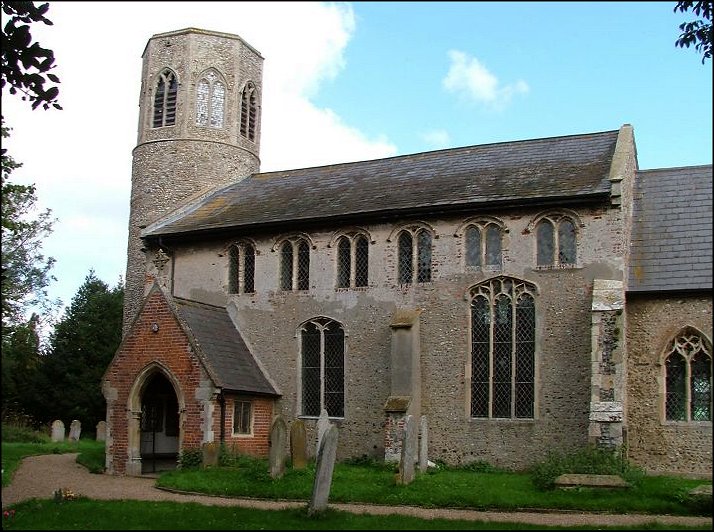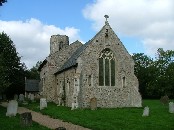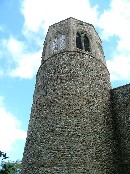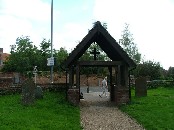| |
|
All
Saints, Poringland
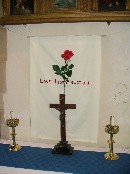 |
|
Poringland
is a very large village to the south-east of
Norwich, merging into Framingham Earl to make
what is really a small town. The big church of
All Saints sits up on the main road, at an angle
to it, presenting its fine 14th century chancel
to the world. Two image niches flank a window
which was blocked up for several hundred years,
finally being cleared in the 19th century. The
side windows of the chancel are even more
elaborately Decorated. All Saints
is one of those churches which really does repay
a considered exploration of its outside. It gives
up its secrets quite easily, and provides a story
of its development over the centuries. Obviously,
the earliest part of the building here is the
lower stage of the round tower, which is
certainly Norman, despite the slightly later
window on its west side. There are not many round
towers in urban settings; there must have been
many more, but most were replaced later by square
towers. That did not happen here, possibly
because Poringland's tower is such a handsome
one.
|
But if All
Saints is a grand and singular church, then this is
because of its nave, which is quite like any other in
Norfolk. As Mortlock observes, there must have been work
going on here pretty well continually from the mid-14th
century to the mid-15th century. At some point in the
middle of this period a massive window was built at the
east end of the south wall, and then in 1450 the walls
were raised and the striking clerestory, picked out in
red brick, was put in. The windows needed to be smaller
above the big window.
As if all
this were not enough, two centuries earlier the Norman
round tower had been augmented by a fine bell stage, the
bell windows alternating with flushwork-filled blanks. As
I say, there is nowhere quite like it. The red brick
porch against the nave is 19th century, and there is a
fine 20th century meeting room concealed on the north
side. But it is the porch you step through into the body
of the church.
When they
built the clerestory, they rebuilt the roof, and it
survives today. It is an attractive colour, a
counterpoint to the furnishings below, but the unusual
proportions of the shape make the interior feel rather
austere, and it would be hard to describe it as
attractive, especially when looking west. The 19th
century restoration was rather severe, and has left the
interior feeling a bit anonymous, although the chancel is
much more successful.
The great
treasure here is the collection of medieval glass reset
in the east window. The central figure shows Christ the
Man of Sorrows, standing and displaying his bleeding
wounds. An awe-inspiring figure, and probably not of
local origin, he called to my mind the words from Isaiah
which open the Good Friday liturgy of the Catholic
Church:
He had no dignity or beauty to
make us take notice of him.
There was nothing attractive about him, nothing that
would draw us to him.
We despised him and rejected him; he endured suffering
and pain.
No one would even look at him - we ignored him as if he
were nothing.
All the while we thought that his suffering was a
punishment sent by God.
But because of our sins he was wounded, beaten because of
the evil we did.
We are healed by the punishment he suffered, made whole
by the blows he received.
All of us were like sheep that were lost, each of us
going his own way.
But the Lord made the punishment fall on him, the
punishment all of us deserved.
He was treated harshly, but endured it humbly; he never
said a word.
Like a lamb about to be slaughtered, like a sheep about
to be sheared, he never said a word.
He was arrested and sentenced and led off to die, and no
one cared about his fate.
He was put to death for the sins of our people.
He was placed in a grave with evil men, he was buried
with the rich,
even though he had never committed a crime or ever told a
lie.
He is
flanked by two other figures. On the left is a composite;
the lower half is, I think, the body of the Angel Gabriel
from an Annunciation scene, holding a banner with the
words Ave Gratia Plena ('Hail Full of Grace').
The wings have been lost, but you can just make out the
stems of the lilies in his right hand. The head is that
of a woman, I think.
The figure
on the right is an image of Christ as the Lamb of God,
holding a cross and a banner. You can see the wounds in
his feet.
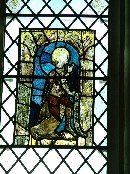 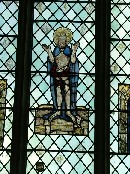 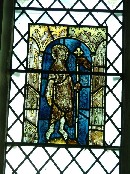
Back in the nave, there is a
typical East Anglian font of the 15th century, looking
very like those nearby at the two Shotesham churches. At
some point, someone has collected a late medieval Italian
altar piece, which now hangs in the nave. It depicts St
Paul and St Peter, founders of the Catholic Church,
flanking two angels raising a chalice to represent
Christ. I loved the simple little altar below it, with
its single red rose and the inscription 'Love
Indestructible'.
We came here on Bike Ride day,
because All Saints is one of the 'fortress' churches, one
of a handful of churches in East Anglia which is not open
to visitors, strangers and pilgrims. I must tell you that
the two ladies on duty were very friendly and jolly, and
could not have been more helpful. Peter, who was with me,
was pleasantly surprised. He had arrived on Good Friday
2004 to find the door locked, and a big sign saying the
church urgently needed funds. While he was trying the
door, a churchwarden arrived, but refused to let him see
inside.
Peter continues: I drew his
attention to the 'funds needed' sign and said, "Why
would I want to donate funds to a church that won't let
me in?"
"Churches have to be kept
locked," he said dismissively. "They all
are."
'Excuse me", I replied.
"I've visited nearly a thousand churches in Norfolk
and Suffolk and found well over half of them open and
almost all the rest have helpful keyholders.'
"Oh well", he countered,
"some of them might be open if they can find someone
to be on duty all the time."
Again, Peter had to contradict him.
"I've found someone on duty at less than ten of the
big ones, and only at Sandringham among the small
ones." At this point, the churchwarden said he had
to get on with his work, and suggested that if Peter
wanted to see inside he should come to a service.
Somewhat understandably, Peter
wrote to the Rector about this altercation. The reply was
conciliatory; the Rector expressed sincere regrets and
said how much he himself loved travelling round the
county and finding small churches open.
| But, he continued, the
problem with Poringland was that it was
unfortunately near a school, and there had been a
lot of vandalism. As Peter says, this is not
easily confirmed; the next time he was in
Poringland he stopped and had a look for broken
windows, or signs of recently repaired ones, a
new lock on the door, overturned gravestones and
so on. Nothing. However,
I am reasonably optimistic, because, as I say,
the people on duty were very friendly; and,
moreover, there was a traffic cone painted with
the words church open in the lychgate.
Surely they didn't make it just to use on bike
ride day?
|
|
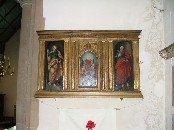 |
|
|
|

